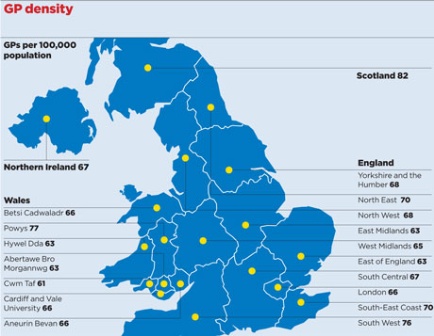Non-GP training posts ‘could be capped’ under radical plan to boost GP numbers
Exclusive Health education chiefs are set to consider capping the number of trainees entering non-GP specialties under radical plans being considered by advisers to alleviate the GP recruitment crisis.
Pulse has learnt that an advisory group set up by Health Education England to help meet its mandate to boost the proportion of medical graduates going into general practice to 50%, is looking at limiting the number of trainee posts for hospital doctors and other non-GP specialties.
The move comes as a Pulse investigation revealed the extent of the workforce crisis. Data from 8,088 GP practices in England, collected by the Health and Social Care Information Centre, shows that – excluding locum support – 149 practices had more than 4,000 patients per FTE GP and 75 were coping with more than 5,000 per GP.
Growing concerns about the shortage of GPs back in 2012 led former health secretary Andrew Lansley to set out a plan to increase the proportion of trainees going into general practice by 20% to ensure half of all trainees become GPs by 2015. But progress has been slow, with deaneries only increasing the number of GP trainees recruited last year by 95, compared with a target of 3,250 a year.
Pulse understands a GP task force, chaired by Wessex Deanery postgraduate dean Dr Simon Plint, is currently working closely with the Centre for Workforce Intelligence (CFWI) to make recommendations on how to deliver on the number of national training posts required by 2015 and is due to publish its final report soon.
Related stories
Investigation: Are we at risk of running out of GPs?
A source close to the task force said it was ‘looking at ways of marketing GP as a career to medical students and foundation doctors, increasing training capacity and resources, capping recruitment into other specialities and strategies to increase retention’.
But the idea has been criticised by GP leaders who warn the plans are ‘extremely short-sighted’ as medical graduates forced to become GPs will leave.
Dr Beth McCarron-Nash, GPC lead on education and training, said: ‘If you look at the evidence a significant number [are leaving] very early on after qualification – and that is a big concern. I think capping of other specialties and forcing doctors into general practice is extremely short-sighted because they’ll just leave.’
She added: ‘We need to make sure general practice is an attractive career option so we get the brightest young doctors who want to be GPs, and ensure GPs of the future are there for the right reasons.’
Dr Krishna Kasaraneni, chair of the GPC training subcommittee and a member of the BMA Junior Doctors Committee, agreed that medical graduates should be motivated rather than forced to join general practice.
Dr Kasaraneni said: ‘I don’t want anyone to be forced into general practice, they need to be encouraged to pursue that as an option. It’s not that hospitals are over-filled with consultants – we still need doctors in both primary and secondary care, but we need more GPs and any innovative way of making it happen we are open to.’
A spokesperson for HEE would not comment on the plan to cap specialities, but said: ‘We are anticipating a requirement in our refreshed mandate to report later this year on training requirements for the GP workforce and the information in the taskforce report will be one of the resources we look at as part of that wider work.’
Information from the CFWI report into the GP workforce last year showed there was a doubling in the number of hospital consultants trained between 1995 and 2011 and a 50% rise in other non-GP specialists, compared with only a 30% rise in the number of GPs.
Investigation: Are we running out of GPs?
A Pulse investigation has found that 21 practices across parts of London, the North and the Midlands are facing as extreme a situation as one area in North-East Essex, where NHS England has stepped in to help with recruitment, with one full-time GP serving more than 8,000 patients.
Click here to read the full investigation.










